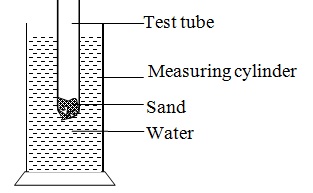Question
(a) Distinguish between density and relative density of a substance
(b) A ship of mass 1300 tonnes floats on sea water:
(i) What volume of sea water is displaced (Density of sea water is 1025kg/m3)
(ii) Suppose it sails from sea water to fresh water, what cargo must be removed so that the same volume of water is displaced? (Density of fresh water = 1000kg/m3
(c) Describe an experiment to verify the law of flotation
(b) A ship of mass 1300 tonnes floats on sea water:
(i) What volume of sea water is displaced (Density of sea water is 1025kg/m3)
(ii) Suppose it sails from sea water to fresh water, what cargo must be removed so that the same volume of water is displaced? (Density of fresh water = 1000kg/m3
(c) Describe an experiment to verify the law of flotation
Answer
(a) Density is the mass per unit volume of a substance, while relative density is the number of times a substance is denser than water
(b)
(i) By law of flotation,
Mass of the ship = mass of water displaced
Mass of water displaced = 1300000kg
 (ii) Weight of ship - weight of cargo = upthrust in fresh water
(ii) Weight of ship - weight of cargo = upthrust in fresh water
13,000,000kg - W = weight of water displaced in fresh water
13000000 - W = (1268.3 x1000) x10*TEZ*
W = 13,000,000 - 12, 683, 000
W = 31,7000N
Cargo removed = 317 tonnes
(c) Apparatus
- Measuring cylinder, water, test tube, sand and a weighing balance
 Procedure
Procedure
1. A measuring cylinder is half-filled with water and the level recorded
2. Then a clean dry test tube is placed into the cylinder and some sand is added to it so that it floats upright. The new level of water is recorded.
3. the volume of water displaced is then noted, the test tube is then removed from the cylinder, it is dried and its weight determined
4. The experiment is repeated four times, adding a little more sand each time
Observation
The test-tube sinks deeper with each addition of sand. Weight of test-tube with its contents is equal to weight of water displaced.
A floating object displaces its own weight of the fluid in which it floats.
This is the fluid in which it floats.
This is the law of flotation
(b)
(i) By law of flotation,
Mass of the ship = mass of water displaced
Mass of water displaced = 1300000kg

13,000,000kg - W = weight of water displaced in fresh water
13000000 - W = (1268.3 x1000) x10*TEZ*
W = 13,000,000 - 12, 683, 000
W = 31,7000N
Cargo removed = 317 tonnes
(c) Apparatus
- Measuring cylinder, water, test tube, sand and a weighing balance

1. A measuring cylinder is half-filled with water and the level recorded
2. Then a clean dry test tube is placed into the cylinder and some sand is added to it so that it floats upright. The new level of water is recorded.
3. the volume of water displaced is then noted, the test tube is then removed from the cylinder, it is dried and its weight determined
4. The experiment is repeated four times, adding a little more sand each time
Observation
The test-tube sinks deeper with each addition of sand. Weight of test-tube with its contents is equal to weight of water displaced.
A floating object displaces its own weight of the fluid in which it floats.
This is the fluid in which it floats.
This is the law of flotation

